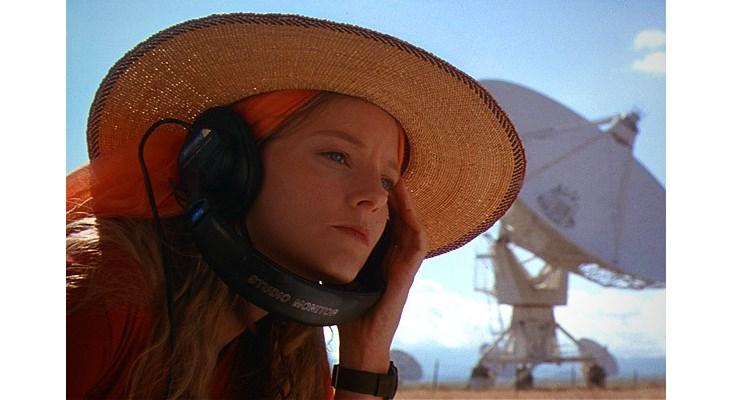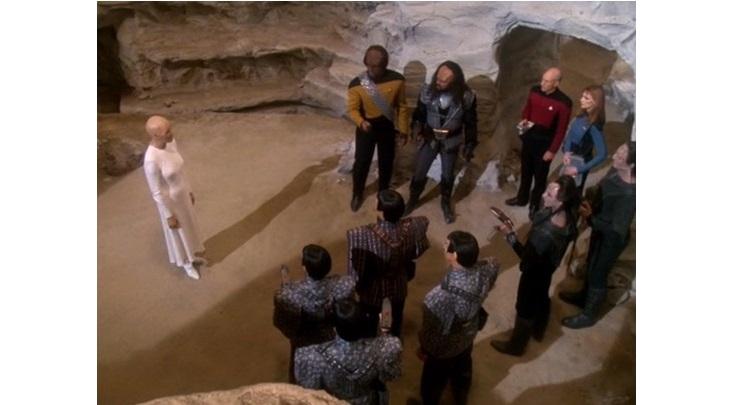
When people think about SETI, the Search for Extraterrestrial Intelligence, they imagine messages sent via radio—Jodie Foster tuning antennas, hoping to pick up signals from the “billions and billions” of star systems pondered by Carl Sagan. Potential extraterrestrials might be beaming out messages into space and all we need to do is listen for them. Of course, even using light—the fastest possible signal-carrier—we would still have to wait years for messages from even the closest stars to reach us. And that presumes that we are listening at just the right moment in the Universe’s 13.8-billion-year history. The odds that different civilizations across the galaxy overlap so precisely that we could listen right now to aliens’s messages could be quite low.
But there’s another potential way to send signals across the cosmos, albeit one that requires a great deal of patience and expertise: storing messages inside genetic material. Encoding a message in an organism or virus and then sending it on an interstellar voyage to other planets requires a long wait—it might take eons for intelligent life to evolve on the destination planet, where the message is waiting—but these organisms, packed with a message, are patient, and they are fecund. They quietly reproduce, carrying and copying the message hidden within their informational backbones. Until one day a sentient being takes notice of the momentous message all around it (or even within itself): “You are not alone.”
If this sounds like something out of science fiction, that’s because it is. When I was in elementary and middle school, I loved Star Trek: the Next Generation. I grew up on it. And in one of the later seasons, an episode aired that examined this idea.
This particular episode’s plot revolves around a chase to collect pieces of genetic material, ones that turn out to exist within many of the intelligent species commonly found in Star Trek. Humans, Klingons, Romulans, and more, all turn out to be related to a common ancestor, who placed information about our origins—that our planets were all seeded with biological information by this progenitor—within our own ancestral genomes. A fun idea, which sent the characters on an Indiana Jones-style romp in search of biological samples necessary to put together the genetic puzzle.

This story is not the only instance of this concept, which has appeared enough in sci-fi to be the subject of parody: The characters in the online comic strip Dresden Codak find a message hidden within terrestrial DNA that turns out to be an interstellar chain letter promising “fabulous prizes” for anyone who “forward[s] this to at least TWO of ur [sic] favorite planets.”
But this concept also has a clear scientific pedigree as well. Francis Crick, the co-discoverer of the structure of DNA, thought about directed panspermia—the idea that living matter was sent by extraterrestrials between the stars—and it is only a short mental hop to the next step: sending messages within these living things. In fact, soon after the first complete genome was decoded in the 1970s, it was tested for alien messages.
The first genome to be decoded was the short and simple genetic sequence of a bacteriophage—a virus that infects bacteria—known as ΦX174. It infects Escherichia coli, or as the authors of the investigation evocatively put it, “an enteric bacterium inhabiting the colon of the only intelligent beings on the Earth.” The authors took a chunk of the genome that is responsible for coding for two different proteins and tried to examine its information for any potential message. This section of DNA codes for 121 amino acids (with three nucleotides, or “letters,” of DNA for each amino acid), a special number in that it is a multiple of two primes: if you are trying to create an image out of this section, with each amino acid represented by one pixel, it would always be 11 pixels across and 11 down. There’s no other way to divide it up. The researchers tried a number of different ways of visualizing this stretch of DNA—for instance, by coding two letters of DNA as a dark square and the other two as a light one, and by looking at one nucleotide of each triplet at a time. They also looked at some other parts of the genome. Unfortunately, nothing jumped out. The authors noted some of their work’s shortcomings—a virus tailored to infecting one specific species on one specific planet is far less likely to be chosen as a vehicle for an interstellar message than something that can live independently, like a bacterium or a fungus—but there simply weren’t any other genomes to look at at the time. They were stuck with what they had. But the search had begun.
Several years later, a simian virus was examined for evidence of a star map within it. And more recently, the physicist Paul Davies has proposed looking for messages in the huge amount of genomic information generated since then, using a distributed computational network, which he likens to SETI@Home—NASA’s project that uses citizens’ home computers to help look through troves of telescope data for signs of intelligent aliens.
It’s natural for many of us to look for secrets, whether we hope for hidden passageways behind bookcases or a map scrawled on the back of the Declaration of Independence, as Nicolas Cage would have it. As pattern-seeking creatures, we perceive patterns, connections, and structures even where there are none, a phenomenon known as apophenia.
The geneticist George Church has shown that information can be easily stored in DNA: He and his team used a DNA microchip to write an entire book 70 billion times into DNA. They use a single nucleotide for each bit of the information, encoded in binary, similar to how the researchers looking at the bacteriophage had suspected a smart alien might encode information.
DNA is stable at room temperature and could last for a long time, potentially making it a good information-storage mechanism. But here’s the hitch, as Church explains: “We purposefully avoided living cells. In an organism, your message is a tiny fraction of the whole cell, so there’s a lot of wasted space. But more importantly, almost as soon as a DNA goes into a cell, if that DNA doesn’t earn its keep, if it isn’t evolutionarily advantageous, the cell will start mutating it, and eventually the cell will completely delete it.”
It’s one thing to have a chunk of a DNA crystal sitting around somewhere for tens of thousands of years. But that chunk, no matter how stable, is small. If you want it to really work as a vehicle for a message, it needs to reproduce and spread. So you need to put it into something living. But by doing that, if the message isn’t also useful for the organism, it will quickly mutate into oblivion.
If you write a message in the extra parts of the genome, then these sections can just randomly mutate with impunity. Try coming back in several million years and reading the message, and you’ll find errors graffitied all over the information. On the other hand, if the message is encoded into something that is important to the function of an organism, it will likely be conserved over time, but that would severely limit how the message can be constructed; it’s hard to write “Hello World” into a genetic sequence when it needs to also make an important protein. But perhaps that is the only way to make this kind of thing happen.
The researchers who looked at the bacterial virus anticipated this, and that was one of the reasons they looked in a region of the genome that was responsible for not one but two proteins. There is evolutionary pressure keeping it from changing over time, so it should be particularly stable.
Many years after my first encounter with this idea, after I had already completed a PhD in computational biology, I returned to it as a fun thought experiment. I decided to test it out on a specific type of biological information: ultraconserved elements. These are several hundred stretches of the genome longer than 200 letters of DNA that are completely or nearly identical across many different animals—from humans to rats—separated by hundreds of millions of years of divergent evolution. If any place could hold a message, it might be these strings of information, first studied a little more than 10 years ago. I examined some of these sequences of DNA bases that, like 121, happened to be the length of the product of two primes—in this case, I was interested in sequences that could make nice square or rectangular images. I tried visualizing the data, with each of the four bases of DNA represented by a different color. Again, after this cursory examination, nothing jumped out.
But the episode of Star Trek got it: The seeds that the progenitor species developed for the primordial soups of many planets (which eventually led to humanoid life) also contained the message. When it comes to ultraconserved elements, many of these do seem to have vital biological functions, so any message within them would do important double duty. Of course, it might be possible to have a message persist, even if it doesn’t do anything useful, if you make lots and lots of copies of it in a genome. But more likely than not, an overlap of function and information would be far more capable of persisting through the long journey between stars and the long delay through evolutionary time waiting around for someone able to read the message.
Then again, this could just be nothing more than science fiction and something that speaks to our psychology. The science writer Dennis Overbye compares our yearning to find secrets in our DNA to playing Beatles records backwards and listening for cryptic messages. It’s natural for many of us to look for secrets, whether we hope for hidden passageways behind bookcases or a map scrawled on the back of the Declaration of Independence, as Nicolas Cage would have it.
But the world does not always work this way. As pattern-seeking creatures, we perceive patterns, connections, and structures even where there are none, a phenomenon known as apophenia.
Nevertheless, if these messages, hidden in some terrestrial DNA, do exist, it will take time and patience to determine this. Perhaps, as Davies argued, it is time for a massive effort that combs through all the digitized genomic information we have generated. An open-source project that does just this would be exciting for those interested in both astronomy and biology, whether or not it yields any sort of finding.
But one thing is likely. Any message that is found will be discovered in the regions most precious to our survival: the ones that ensure we are able to pass our genes on to the next generation. Anything less and it would have likely been swept away long ago by the constant churn of evolution.
Samuel Arbesman is a senior adjunct fellow of the Silicon Flatirons Center for Law, Technology, and Entrepreneurship at the University of Colorado and the author of The Half-Life of Facts.






























